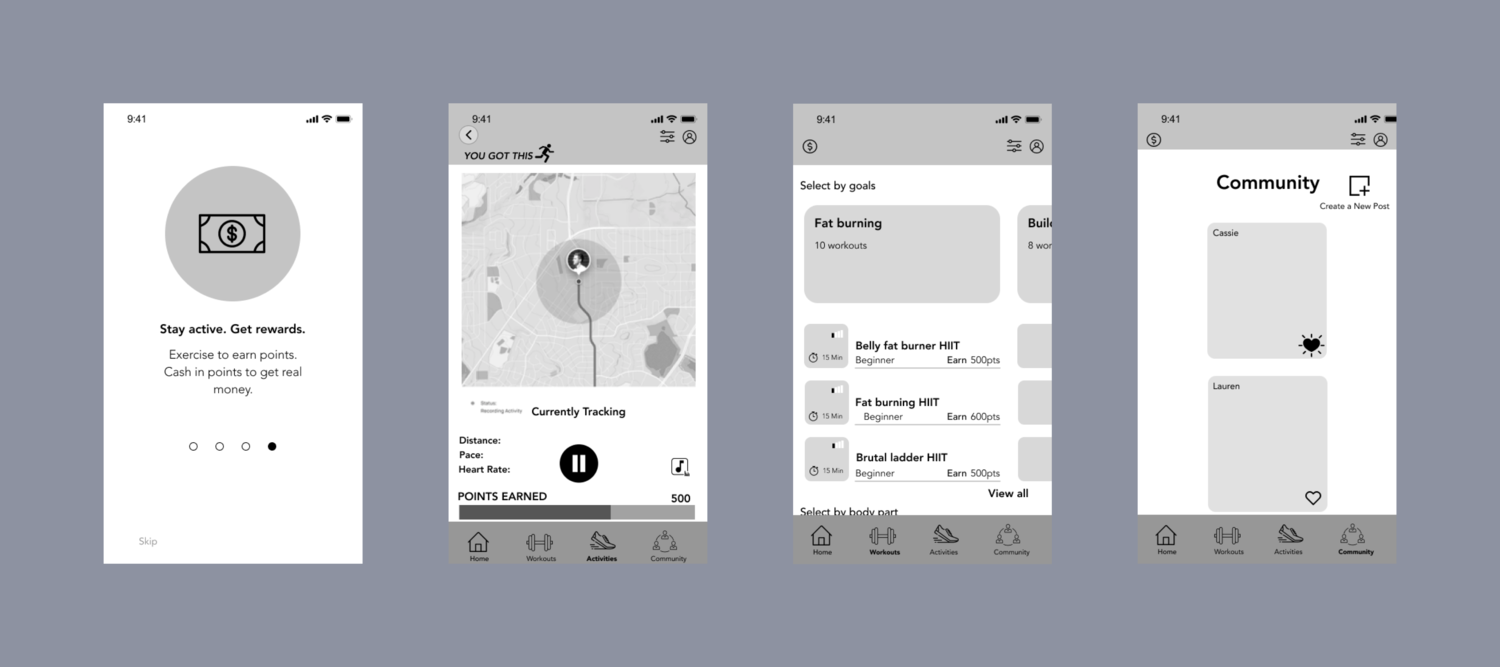Force Fit
A Specialized Fitness Experience

Millennials are seeking alternative ways to stay happy, healthy, and active due to the COVID-19 pandemic affecting their lifestyles. It is believed to be that millennials have more of an appetite for adventure, risk-taking, and specialized fitness experiences. My design team and I were tasked with carving out a new opportunity in this millennial-driven product market.

The Background
The Problem
Active millennials need a specialized fitness experience to tailor to their fitness needs, especially now during the COVID-19 pandemic. Users are frustrated with the inability to connect with others and stay motivated in their fitness routines while working out from home.
My Role
My role was to research the needs, goals, motivations, and frustrations of millennials around health and fitness and utilize a user-centered design approach to solve for their needs in addition to create the product derived from that research. My team was made up of four user experience designers, including myself.
Deliverables
User Research, User Interview Insights, Mid - Fidelity Wireframes, Usability Test, Interactive Prototype, + Annotated Wireframes over the course of seven weeks.
How I tackled this problem
1. Research
Conduct user + market research to learn about the fitness market and specialized features or trends in the market
2. Strategy
Get to know our users better and begin to workshop solutions
3. Design
Prototype, test, and iterate

1. Research
Discoveries
Force Fit is a company that wants to improve the way people exercise at home. Although many millennials exercise in traditional gyms, our task was centered around seeking specialized health and fitness opportunities that align with our target audiences’ unique identity, in addition to the need for an at-home experience.
Competitive Analysis
Through our competitive analysis of looking into five direct competitors and one indirect competitor, we were able to identify trends and opportunity gaps. We looked at specialized fitness products as well as a social community gaming service.

Survey
My team and I utilized Google Forms to create a survey to gain insights on what millennials need in a fitness experience, given the current circumstances of the COVID-19 pandemic. We felt it was important to send out a survey to gain more insight into the millennial fitness domain. We gathered insight from around 100 individuals.
Key Insights
Users want the ability to connect with others via fitness, validating that social media for this group is important
Users are more likely to work out at home, especially now due to the effects of COVID-19. Prior to the pandemic, users began experimenting with at-home fitness due to time constraints with work and social obligations
User Interviews
We then went on to interview a total of ten potential users, all millennials who value an active lifestyle. Our users ranged from graduate students to teachers to young entrepreneurs.
Key Insights
Users are willing to pay for a fitness tool that will help them stay accountable, connected, and motivated
Create a platform for this by allowing incentives, social connection, and fitness tracking which will also give ForceFit a competitive edge
Creating a mobile application would be most beneficial as all users interviewed stated that they use their smartphones the most for finding new workouts or listening to music
Subject Matter Expert Interviews
We interviewed a total of five fitness or nutrition experts to better understand the domain concerning COVID-19. Our SME’s ranged from nutritionists to personal trainers.
Key Insights
Equip users with the proper knowledge of nutrition and how it affects their mind and bodies
Inputting data (workouts, food) can help users understand how their diet and fitness work for or against each other
Staying up to date on how to best take care of ourselves is key, especially during this time

2. Strategy
User Persona
Following our initial market research and competitive analysis, I went on to create a user persona to help better understand who ForceFit’s users are and would be.
Meet Julia
Julia is frustrated that she isn’t able to workout with her friends at their normal fitness classes due to COVID-19. She wants to feel confident in her health and fitness decisions, because consistently moving her body drives her overall happiness. She wants to be able to maintain a sustainable workout routine that she wants to come back to every day and connect with others during this time.

Problem Statement
Millennials like Alex, whoes motivation has been disrupted to maintain a consistent fitness routine need a variety of tools to help create healthier, sustainable, and enjoyable fitness habits.
Design Principles
More Effort, More Rewards
The harder you work, the bigger the rewards you get
Better
Together
People who train together, grow together
Evolves
Alongside You
As your fitness goals and lifestyle change over time so do your workouts

3. Design
Brainstorming Session
We utilized the 6-8-5 method for multiple rounds of sketching
Iterate + Diverge
After creating paper prototypes, I iterated and created mid-fidelity wireframes. We created our concepts based on our research with Alex in mind. Some of the divergent concepts focused on an outdoor activity section and an incentive-based workout program.
The mid-fidelity prototype that I created was focused on structural exercise instruction with video guidance.
Key Insights
I conducted two usability test interviews using my mid-fidelity prototype and discussed my findings with my team
Users found the community aspect to be appealing and valuable and enjoyed the ability to share their workouts on a workout specific app with others who share their same interests
Our assumptions that users want to connect socially via fitness was validated through this insight

Iterate again + Prototype
My teammates and I created one converged prototype including the concepts from each of our individual wireframes and tested a total of ten people on their ability to flow through the app. The screens that tested well included social interactivity as well as the incentives. Users found the onboarding process in one concept to be confusing, so we made sure to iterate on that and create an easier to understand onboarding flow during convergence.
Key Insights
Majority of users (indicated more than 50%) responded well to the incentives experience because they liked that they could earn a gift card and points earned towards a reward, they found this motivating and would use this mobile application for that very reason.
100% of users were able to engage correctly with the social interactivity, citing how easy it was to post a photo or like another user's post.
Users found great value in the ability to complete an outdoor activity within the app.
Retrospective
This project taught me how to work collaboratively on a team and work through personal constraints and conflicting ideas while still being able to compromise and keep the users at the forefront of our designs. I was able to learn Figma in a short amount of time - from wireframing to interactive prototyping. I still want to work on learning how to get even better at prototyping through Figma.









